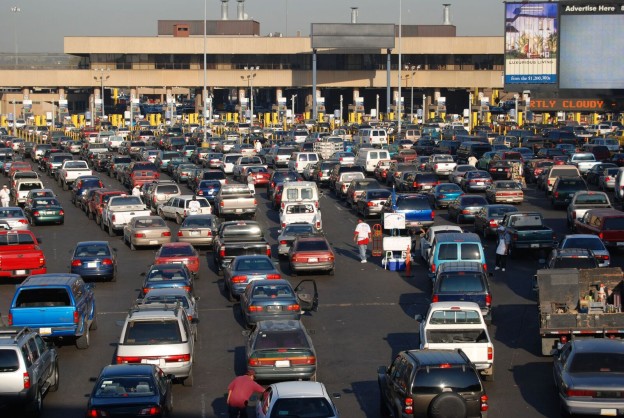Stereotypes of the U.S. border abound, from the travails of immigrants to drug cartel excesses. However, another, future-looking story is emerging at the U.S. Mexico border where the cities of San Diego and Tijuana have become a hub for innovative approaches to health care, transportation, education, government, manufacturing and workforce development.
San Diego and Tijuana are the two largest cities in the CaliBaja Bi-National MegaRegion which boasts morethan 6.5 million residents and includes San Diego County, Imperial County and Baja California in Mexico.
Tijuana is home to more than 600 maquiladoras, factories in Mexico run by foreign companies who then export their products back to those countries.
“These businesses have developed a new cross-border manufacturing co-creation model that involves binational collaboration in the engineering and design of products, of manufacturing processes, of software and other business functions. says Flavio Olivieri, the executive director of CaliBaja. “This leverages the capabilities and talent of the bi-cultural workforce.”
Steven Pedigo, the director of New York University’s Schack Institute Urban Lab says that “in the case of San Diego and Tijuana, one side of the border excels in research and design, the other in manufacturing. One side is rich in capital, the other in skilled, cost competitive labor. In short, each has its own strengths and specializations.”
Andy Carey, executive director of the Border Philanthropy Partnership, puts it more simply, “Both sides of the border butter each other’s bread.” Olivieri says some of the most successful examples of this binational co-production are Plantronics, Solar Turbines, Skyworks, Honeywell and DJO Global in the manufacturing sector. Simnsa, Codet Vision, Sanoviv and Rancho La Puerta in healthcare. Softtek, ArkusNexus, and Thermo Fisher in software. These companies take advantage of the skilled workforce and Tijuana’s manufacturing capability.
“This is an ongoing and evolving model of regional integration” says David Mayagoitia, the chairman of the Tijuana Economic Development Corporation. Every dollar U.S. companies spend in Mexico returns 40 cents to the U.S., meaning the international firms located in Tijuana also generate economic activity for San Diego, helping create a $205 billion, cross-border regional economy. Much of this comes through the 70 million people crossing the San Diego/Tijuana border annually.
Mayagoitia says more than 60,000 U.S. citizens live in Tijuana’s urban core and along its beaches and coast, many taking advantage of modern condominiums in secured buildings at half the cost of equivalent lodging in San Diego.
Contributing to Tijuana’s urban renaissance are developers like Miguel Marshall, a cross-border entrepreneur with dual citizenship in both the U.S. and Mexico. Marshall wanted to create an urban experience in Tijuana similar to what he had seen in big cities like San Francisco, New York and Mexico City.
“I wanted to shape the cross-border lifestyle, where it doesn’t feel much different no matter what side of the border you are on. I wanted a place where I could live and walk to get a beer, a coffee, or to eat a taco.” Marshall says.
Marshall has developed Estación Federal, a project with connectivity to the border, San Diego, and Tijuana’s downtown. Estación Federal is adjacent to a new pedestrian border crossing, the project to rebuild the bridge connecting the border district to downtown, and a proposed bus rapid transit station.
He repurposed a gas station and vacant office space into a mixed use residential, office and retail complex. Marshall asked the neighbors what they would like included in the project which resulted in a laundromat that could serve both neighbors and project residents, a cafe, a public space, and security for the nine-square- block Colonia Federal neighborhood. Marshall is now proposing a park adjacent to his project that will welcome pedestrians crossing into Mexico with green space.
Across the border, in San Diego’s San Ysidro neighborhood, Miguel Aguirre has been spearheading the Border Fusion project. Aguirre imagines rebuilding the San Ysidro border crossing into a grand plaza welcoming visitors to the U.S. and connecting transportation in both cities. Health care costs considerably less in Mexico than in the U.S., leading to innovation in this area, too. SIMNSA, a health plan firm, is offering insurance to U.S. employers that can be used in Mexico to take advantage of those lower costs.
According to Alejandra Mier y Teran, the executive director of the Otay Mesa Chamber of Commerce, the latest effort to make the border more efficient is a joint cargo inspection program. In the past, trucks would wait between 30 minutes to five hours to complete inspections by Mexican officials and then again by U.S. officials. “Now, it is expected the joint inspections will cut wait times by more than half for the 3,500 trucks crossing into the U.S. daily,” Mier y Teran says.
Corporate sustainability is alive in Tijuana, too. The multinational manufacturing companies operating maquiladoras follow corporate directives maintaining image and compliance and have more proactive and systematized efforts of sustainability, according to
Olivieri. “They promote training programs, recycling, energy efficiency and the use of renewables. They involve their thousands of employees in beach cleanup days, and
they work with schools on environmental education” he says.
UCSD professor Olivia A. Graeve has created two innovative cross-border programs. A native of Tijuana, named by Forbes as one of the 100 most powerful women in Mexico, she directs the CaliBaja Center for Resilient Materials & Systems that builds research and education collaborations with international partners in the area of extreme materials and devices, medical device manufacturing, and environmental technologies.
Graeve also founded the CaliBaja Education Consortium, allowing students to do research and take classes at UCSD and at thirteen Baja California institutions in the consortium.
Aron Davidson, a senior international trade specialist with the U.S. Commercial Service, thinks the California/Baja border region is a natural testbed for disruption. “The various dynamic forces that intersect here foster new ways of thinking about business and how to do business,” he says.
In a December 30, 2017, story, Christopher Hawthorne, the architecture critic for the Los Angeles Times, wrote that “human beings build two kinds of things in the world. We build connective things and we build protective things. We build tunnels and we build walls.”
It is clear that in the CaliBaja Bi-national MegaRegion, despite fences and wait times, the region is focused literally and figuratively on creating the connections through which innovation flows in both directions.


